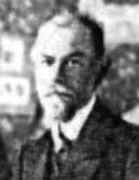Person: Egorov, Dimitri Fedorovich

Dimitri Egorov was a Russian mathematician who worked in differential geometry and mathematical analysis.
Mathematical Profile (Excerpt):
- Dimitri Fedorovich was educated at home for the first part of his life and only when he reached secondary school age did he begin his formal school education.
- The teacher to influence him most at this time was Nicolai Vasilievich Bugaev but he also attended lectures from Alexandr Ivanovich Nekrasov, Nikolai Egorovich Zhukovsky, the geometer Vasilii Yakovlevich Tsinger (1836-1907), and the physicists Aleksandr Grigorievich Stoletov (1839-1896) and Aleksei Petrovich Sokolov.
- Egorov wrote his first paper Some relations in the theory of integrals over divisors while still an undergraduate.
- After the award of his first degree, Egorov remained at Moscow University working towards his Master's Degree (equivalent to a Ph.D.).
- In the Egorov apartment, located on Boris and Gleb Street in the prestigious Arbat region of Moscow, music was often in the air.
- Egorov worked on triply orthogonal systems and potential surfaces, making a major contribution to differential geometry.
- Some of the results of Egorov's doctoral dissertation were presented by Darboux in his famous four volume work Leçons sur la théorie général des surfaces et les applications géométriques du calcul infinitésimal (1910).
- A theorem in the theory of functions of a real variable is now named after Egorov.
- Vyacheslaw Vassilievich Stepanov, one of Egorov's pupils, regarded the publication of this paper as marking the birth of a new Moscow School of Mathematics.
- In 1923 Egorov published the book Principles of the calculus of variations.
- Egorov also worked on integral equation publishing significant papers such as Sur quelques points de la théorie des équations integrates à limites fixes and Sur la théorie des équations integrates au noyau symmetrique which were both published in 1928.
- However, the formal merits, refinements of calculation, always the shortest path of logical deduction, possibly sometimes even overwhelmed the listener, who in Egorov's lectures received every mathematical theory in its definitive crystallized form.
- Nikolai Nikolaevich Luzin was Egorov's first student and became a member of the school Egorov created in Moscow dealing with functions of a real variable.
- Egorov and Luzin are now considered as joint founders of the influential Moscow School of Pure Mathematics.
- In 1917 Egorov became secretary of the Moscow Mathematical Society.
- In 1923 Egorov became director of the Institute for Mechanics and Mathematics at Moscow State University which had been founded two years earlier.
- Also in 1923 Egorov was appointed as Chairman of the Mathematics Syllabus Commission of Moscow University.
- when the church building was converted into a student club, dance hall, and auditorium, Egorov pointedly refused to attend any of the events held there, considering them a desecration.
- From within mathematics, Ernst Kol'man (1892-1979) was a Marxist who began to attack Egorov.
- A university professor was poorly paid at this time, and Egorov had been teaching part-time at the Civil Engineering Institute in Moscow from the early 1920s to supplement his income.
- Soon after this Egorov was dismissed from his position at the Institute and Nikolai Grigorievich Chebotaryov was appointed to fill the vacant position.
- Now Egorov was still in a position of power in the Moscow Mathematical Society and he tried to shelter academics who had been dismissed from their posts.
- The USSR Academy of Sciences seemed at first to offer Egorov their support for on 13 February 1929 he was made a full member.
- In the spring of 1930 Egorov was dismissed as director of the Institute for Mechanics and Mathematics and given a public rebuke.
- The Moscow Mathematical Society continued to support Egorov, refusing to expel him, and those who presented papers at the next meeting, including Aleksandr Gennadievich Kurosh, were to be expelled by an "Initiative group" who took over the Society in November 1930.
- They expelled Egorov denouncing him as a reactionary and a churchman.
- Prof Egorov, a reactionary and a churchman, headed the society.
- The Society expelled Egorov and other reactionaries, and replaced them mainly with graduate students ...
- Egorov spent a short time in prison in Moscow, then was sent to prison in Kazan.
- He was too ill to be saved, but Maria Smirnitskaia signed Egorov's death certificate before his death and told the guards that he had died.
- Egorov was buried in the Arskoe Cemetery in Kazan after a funeral attended only by Chebotaryov and Egorov's wife.
Born 2 December 1869, Moscow, Russia. Died 10 September 1931, Kazan, USSR.
View full biography at MacTutor
Tags relevant for this person:
Origin Russia
Thank you to the contributors under CC BY-SA 4.0! 

- Github:
-

- non-Github:
- @J-J-O'Connor
- @E-F-Robertson
References
Adapted from other CC BY-SA 4.0 Sources:
- O’Connor, John J; Robertson, Edmund F: MacTutor History of Mathematics Archive
